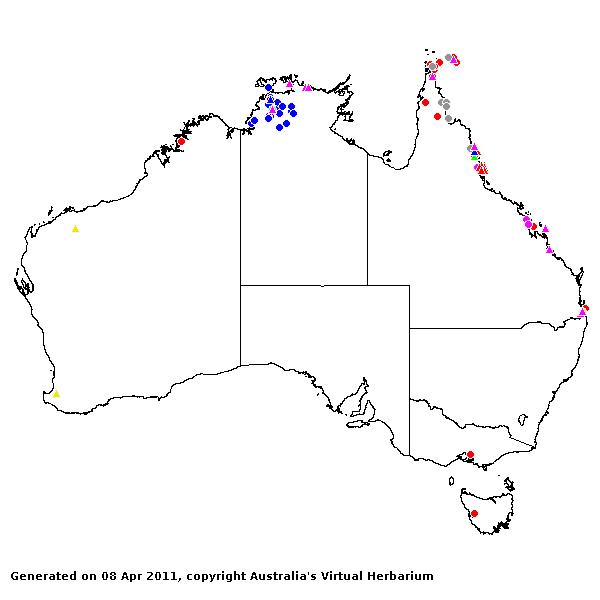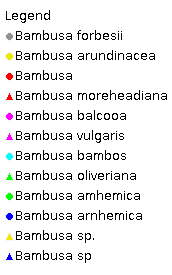Bambusa Gen. Pl. 236 (1789).
Derivation:.
Said to be the Latinised form of the Malayan vernacular name, bambu.
Key references
(keys and floras):. S.W.L.Jacobs and S.M.Hastings, Flora of New South
Wales 4: 656 (1993); B.K.Simon, Key to Australian Grasses 76 (1993);
E.Edgar and H.E.Connor, Flora of New Zealand 5: 21–23 (2000); D.Sharp
and B.K.Simon, AusGrass (2002), in part; S.W.L.Jacobs, R.D.B.Whalley
& D.J.B.Wheeler, Grasses of New South Wales, 4th Ed, 166 (2008);
A.Wilson (ed.), Flora of Australia 44A: Poaceae 2: 352–354
(2009).
W.D.Clayton &
S.A.Renvoize, Genera Graminum (1986), genus (4).
Native (also a number
of commonly cultivated species, which are not naturalised). About 120 species,
from tropical and subtropical Asia, Africa, America. 3 species in Australia, NT
and Qld. Also New Guinea, Malesia and New Zealand.
Habit.
Perennial, bamboo. Culms woody and persistent. Leaf blades broad or narrow
(small to moderate-sized). Leaf-blades pseudo-petiolate. Ligule an unfringed
membrane to a fringed membrane.
Inflorescence.
Inflorescence paniculate (of pseudospikelets, these solitary or in tufts,
fascicles or capitula on leafless branches), an open panicle with branches
ending in single spikelets, open, spatheate (with or without foliage leaves), a
compound pseudo-inflorescence. Spikelet-bearing axes much reduced or paniculate
to capitate.
Spikelets.
Spikelets laterally compressed to subterete, more than 2 flowered, with 2 or
more fertile florets, solitary; with naked rachilla extension. Fertile
spikelets with lower incomplete floret(s) or without lower incomplete
floret(s), disarticulating above glumes.
Glumes. Glumes
more or less equal (usually 2, more rarely 1 or 3), shorter than adjacent
lemmas, hairless, awnless, keeled, similar. Lower glume longer than half length
of lowest lemma, 7–18 nerved. Upper glume 7–18 nerved.
Florets. Lower
incomplete floret(s) if present sterile. Lemmas awnless, several-nerved,
exceeded by fertile lemmas, similar in texture to fertile lemmas. Fertile
florets 1–20 (-many). Lemmas similar in texture to glumes, not becoming
indurated, entire at apex, blunt, muticous, 9–22 nerved, glabrous, 1 keeled to
not keeled. Palea relatively long, entire to apically notched, several nerved
(about 6–16). Palea keels winged or wingless. Distal incomplete florets
underdeveloped. Lodicules 2–3. Stamens 6. Stigmas 3 (usually). Grain
longitudinally grooved, with hairs confined to a terminal tuft. Hilum
long-linear. Embryo small.
Kranz Anatomy.
C3.
2n = 24,
46, 48, 70, and 72, 4 and 6 ploid (rarely diploid), commonly adventive.
Classification.
Bambusoideae; Bambuseae.
Notes. Bambusa
was formerly recognised as a genus from both Old and New Worlds, distribution
being mostly in Asia and Central to South America. All American species
formerly placed in Bambusa are currently accepted as members of the
genus Guadua (Judziewicz, Clark, Londono and Stern, 1999) (B.K.Simon).
Types Species. B.
arundinacea (Retz) Willd.
Biogeographic
Element. Clifford & Simon 1981, Simon & Jacobs 1990: Indo-Malayan.


